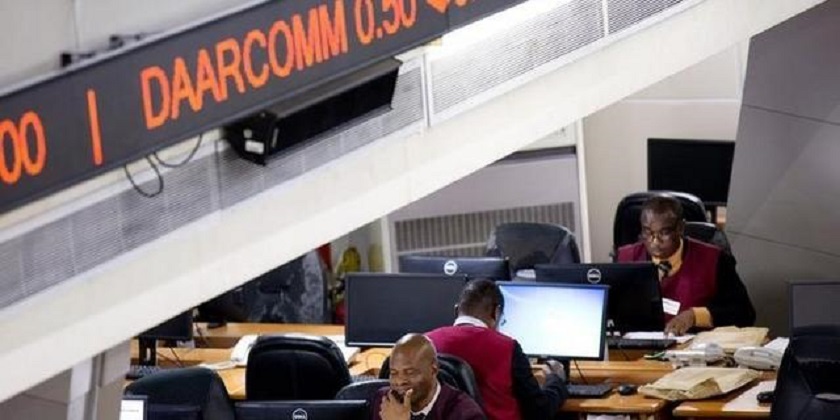Economy
Wall Street Opens Higher Monday on Trade Deal Optimism

By Investors Hub
The major U.S. index futures are currently pointing to a higher opening on Monday, suggesting stocks will see further upside following the rally last Friday.
The markets may benefit from optimism about a U.S.-China trade agreement, with Commerce Secretary Wilbur Ross expressing optimism phase one of a trade deal could be signed this month.
?We?re in good shape, we?re making good progress, and there?s no natural reason why it couldn?t be,? Ross said in an interview with Bloomberg on Sunday.
Ross called the phase one agreement ?particularly complicated? and acknowledged it is ?always possible? the signing of the deal could ?slip a little bit.?
In the interview, Ross also said licenses for U.S. firms to sell components to China?s Huawei Technologies would be coming ?very shortly.?
President Donald Trump has also continued to express optimism about a trade deal, recently suggesting phase one of an agreement could be signed somewhere in the U.S. as soon as this month.
Stocks moved sharply higher over the course of the trading session on Friday as traders reacted to much better than expected U.S. jobs data. With the strong upward moves, the Nasdaq and the S&P 500 reached new record closing highs.
The major averages saw further upside going into the close, ending the session at their best levels of the day. The Dow surged up 301.13 points or 1.1 percent to 27,347.36, the Nasdaq soared 94.04 points or 1.1 percent to 8,386.40 and the S&P 500 jumped 29.35 points or 1 percent to 3,066.91.
For the week, the Dow shot up by 1.4 percent, while the Nasdaq and the S&P 500 skyrocketed by 1.7 percent and 1.5 percent, respectively.
The rally on Wall Street came as the much stronger than expected U.S. jobs data washed away concerns about the economic outlook.
The Labor Department said non-farm payroll employment climbed by 128,000 jobs in October compared to economist estimates for an increase of about 89,000 jobs.
The report also showed substantial upward revisions to job growth in September and August, with revised data showing employment jumped by 180,000 jobs and 219,000 jobs, respectively.
With the upward revisions, employment gains in September and August combined were 95,000 more than previously reported.
“The upshot is that the three-month average gain is now 175,000, which is easily enough to outpace population growth,” said Michael Pearce, Senior U.S. Economist at Capital Economics.
He added, “That is in stark contrast with much of the recent survey evidence, which had pointed to a sharp slowdown in employment growth.”
Despite the stronger than expected job growth, the report said the unemployment rate inched up to 3.6 percent in October from 3.5 percent in September. The uptick matched economist estimates.
The unemployment rate crept up from the nearly 50-year low hit in the previous month as a 325-person jump in the size of the labor force more than offset a 241,000-person increase in the household survey measure of employment.
Renewed optimism about a U.S.-China trade deal added to the positive sentiment, as a report from China’s Xinhua News Agency said negotiators have “reached consensus on principles.”
Meanwhile, traders largely shrugged off a separate report from the Institute for Supply Management showing a continued contraction in U.S. manufacturing activity in the month of October.
The ISM said its purchasing managers index crept up 48.3 in October from 47.8 in September, although a reading below 50 still indicates a contraction in manufacturing activity. Economists had expected the index to rise to 48.9.
In the previous month, the index fell to its lowest level since hitting 46.3 in June of 2009, the last month of the Great Recession.
“Comments from the panel reflect an improvement from the prior month, but sentiment remains more cautious than optimistic,” said Timothy Fiore, Chair of the ISM Manufacturing Business Survey Committee. “Global trade remains the most significant cross-industry issue.”
Energy stocks turned in some of the market’s best performances on the day, benefiting for a sharp increase by the price of crude oil.
Reflecting the strength in the energy sector, the Philadelphia Oil Service Index soared by 5.4 percent, the NYSE Arca Natural Gas Index surged up by 3 percent and the NYSE Arca Oil Index jumped by 2.3 percent.
Substantial strength was also visible among steel stocks, as reflected by the 4.3 percent spike by the NYSE Arca Steel Index. The index ended the session at its best closing level in well over a month.
U.S. Steel (X) helped lead the sector higher after reporting a narrower than expected third quarter loss on revenues that exceeded analyst estimates.
Biotechnology, transportation and financial stocks also saw significant strength on the day, while gold, networking and telecom stocks bucked the uptrend.
Economy
Nigerian Stocks Close 1.13% Higher to Remain in Bulls’ Territory

By Dipo Olowookere
The local stock market firmed up by 1.13 per cent on Friday as appetite for Nigerian stocks remained strong.
Investors reacted well to the 2026 budget presentation of President Bola Tinubu to the National Assembly yesterday, especially because of the more realistic crude oil benchmark of $64 per barrel compared with the ambitious $75 per barrel for 2025. This year, prices have been between $60 and $65 per barrel.
Business Post observed profit-taking in the commodity and energy sectors as they respectively shed 0.14 per cent and 0.03 per cent.
But, bargain-hunting in the others sustained the positive run, with the consumer goods index up by 3.82 per cent.
Further, the industrial goods space appreciated by 1.46 per cent, the banking counter improved by 0.08 per cent, and the insurance industry gained 0.04 per cent.
As a result, the All-Share Index (ASI) increased by 1,694.33 points to 152,057.38 points from 150,363.05 points and the market capitalisation chalked up N1.080 trillion to finish at N96.937 trillion compared with Thursday’s closing value of N95.857 trillion.
A total of 34 shares ended on the advancers’ chart, while 24 were on the laggards’ log, representing a positive market breadth index and bullish investor sentiment.
Austin Laz gained 10.00 per cent to close at N2.42, Union Dicon also jumped 10.00 per cent to N6.60, Tantalizers increased by 9.80 per cent to N2.69, Aluminium Extrusion improved by 9.78 per cent to N12.35, and Champion Breweries grew by 9.71 per cent to N16.95.
Conversely, Sovereign Trust Insurance dipped by 7.42 per cent to N3.87, Royal Exchange lost 6.84 per cent to trade at N1.77, Omatek slipped by 6.84 per cent to N1.09, Eunisell depreciated by 5.88 per cent to N80.00, and Eterna dropped 5.63 per cent to close at N28.50.
Yesterday, traders transacted 1.5 billion units worth N21.8 billion in 25,667 deals compared with the 839.8 million units sold for N32.8 billion in 23,211 deals in the preceding session, showing a surge in the trading volume by 76.61 per cent, an uptick in the number of deals by 10.58 per cent, and a shrink in the trading value by 33.54 per cent.
Economy
FrieslandCampina, Two Others Erase N26bn from NASD OTC Bourse

By Adedapo Adesanya
Three stocks stretched the bearish run of the NASD Over-the-Counter (OTC) Securities Exchange by 1.21 per cent on Friday, December 19, with the market capitalisation giving up N26.01 billion to close at N2.121 billion compared with the N2.147 trillion it ended a day earlier, and the NASD Unlisted Security Index (NSI) dropping 43.47 points to 3,546.41 points from 3,589.88 points.
The trio of FrieslandCampina Wamco Nigeria Plc, Central Securities Clearing System (CSCS) Plc, and NASD Plc overpowered the gains printed by four other securities.
FrieslandCampina Wamco Nigeria Plc lost N6.00 to sell at N54.00 per unit versus N60.00 per unit, NASD Plc shrank by N3.50 to N58.50 per share from N55.00 per share, and CSCS Plc depleted by N2.91 to N33.87 per unit from N36.78 per unit.
On the flip side, Air Liquide Plc gained N1.01 to close at N13.00 per share versus N11.99 per share, Golden Capital Plc appreciated by 70 Kobo to N7.68 per unit from N6.98 per unit, Geo-Fluids Plc added 39 Kobo to sell at N5.50 per share versus N5.11 per share, and IPWA Plc rose by 8 Kobo to 85 Kobo per unit from 77 Kobo per unit.
During the trading day, market participants traded 1.9 million securities versus the previous day’s 30.5 million securities showing a decline of 49.3 per cent. The value of trades went down by 64.3 per cent to N80.3 million from N225.1 million, but the number of deals jumped by 32.1 per cent to 37 deals from 28 deals.
Infrastructure Credit Guarantee Company (InfraCredit) Plc finished the session as the most active stock by value on a year-to-date basis with 5.8 billion units valued at N16.4 billion, followed by Okitipupa Plc with 178.9 million units transacted for N9.5 billion, and MRS Oil Plc with 36.1 million units traded for N4.9 billion.
The most active stock by volume on a year-to-date basis was still InfraCredit Plc with 5.8 billion units worth N16.4 billion, trailed by Industrial and General Insurance (IGI) Plc with 1.2 billion units sold for N420.7 million, and Impresit Bakolori Plc with 536.9 million units traded for N524.9 million.
Economy
Naira Crashes to N1,464/$1 at Official Market, N1,485/$1 at Black Market

By Adedapo Adesanya
It was not a good day for the Nigerian Naira at the two major foreign exchange (FX) market on Friday as it suffered a heavy loss against the United States Dollar at the close of transactions.
In the black market segment, the Naira weakened against its American counterpart yesterday by N10 to quote at N1,485/$1, in contrast to the N1,475/$1 it was traded a day earlier, and at the GTBank forex counter, it depreciated by N2 to settle at N1,467/$1 versus Thursday’s closing price of N1,465/$1.
In the Nigerian Autonomous Foreign Exchange Market (NAFEX) window, which is also the official market, the nation’s legal tender crashed against the greenback by N6.65 or 0.46 per cent to close at N1,464.49/$1 compared with the preceding session’s rate of N1,457.84/$1.
In the same vein, the local currency tumbled against the Euro in the spot market by N2.25 to sell for N1,714.63/€1 compared with the previous day’s N1,712.38/€1, but appreciated against the Pound Sterling by 73 Kobo to finish at N1,957.30/£1 compared with the N1,958.03/£1 it was traded in the preceding session.
The market continues to face seasonal pressure even as the Central Bank of Nigeria (CBN) is still conducting FX intervention sales, which have significantly reduced but not remove pressure from the Naira. Also, there seems to be reduced supply from exporters, foreign portfolio investors and non-bank corporate inflows.
President Bola Tinubu on Friday presented the government’s N58.47 trillion budget plan aimed at consolidating economic reforms and boosting growth.
The budget is based on a projected crude oil price of $64.85 a barrel and includes a target oil output of 1.84 million barrels a day. It also projects an exchange rate of N1,400 to the Dollar.
President Tinubu said inflation had plunged to an annual rate of 14.45 per cent in November from 24.23 per cent in March, while foreign reserves had surged to a seven-year high of $47 billion.
Meanwhile, the cryptocurrency market was dominated by the bulls but it continues to face increased pressure after million in liquidations in previous session over accelerating declines, with Dogecoin (DOGE) recovering 4.2 per cent to trade at $0.1309.
Further, Ripple (XRP) appreciated by 3.9 per cent to $1.90, Cardano (ADA) rose by 3.5 per cent to $0.3728, Solana (SOL) jumped by 3.4 per cent to $126.23, Ethereum (ETH) climbed by 2.9 per cent to $2,982.42, Binance Coin (BNB) gained 2.0 per cent to sell for $853.06, Bitcoin (BTC) improved by 1.7 per cent to $88,281.21, and Litecoin (LTC) soared by 1.2 per cent to $76.50, while the US Dollar Tether (USDT) and the US Dollar Coin (USDC) traded flat at $1.00 each.
-

 Feature/OPED6 years ago
Feature/OPED6 years agoDavos was Different this year
-
Travel/Tourism9 years ago
Lagos Seals Western Lodge Hotel In Ikorodu
-

 Showbiz3 years ago
Showbiz3 years agoEstranged Lover Releases Videos of Empress Njamah Bathing
-

 Banking7 years ago
Banking7 years agoSort Codes of GTBank Branches in Nigeria
-

 Economy3 years ago
Economy3 years agoSubsidy Removal: CNG at N130 Per Litre Cheaper Than Petrol—IPMAN
-

 Banking3 years ago
Banking3 years agoFirst Bank Announces Planned Downtime
-

 Banking3 years ago
Banking3 years agoSort Codes of UBA Branches in Nigeria
-

 Sports3 years ago
Sports3 years agoHighest Paid Nigerian Footballer – How Much Do Nigerian Footballers Earn












